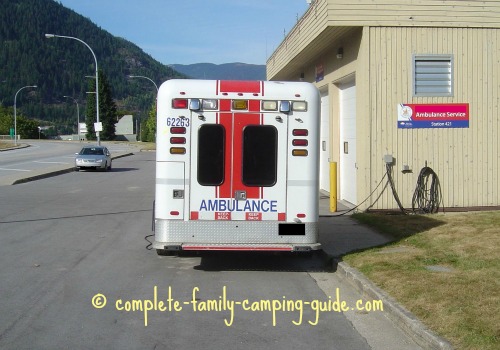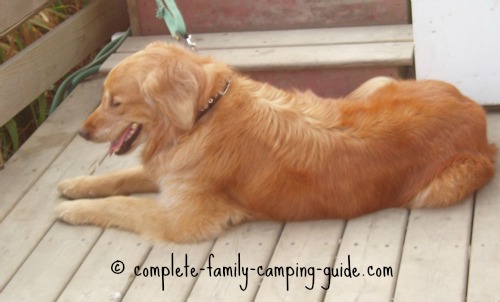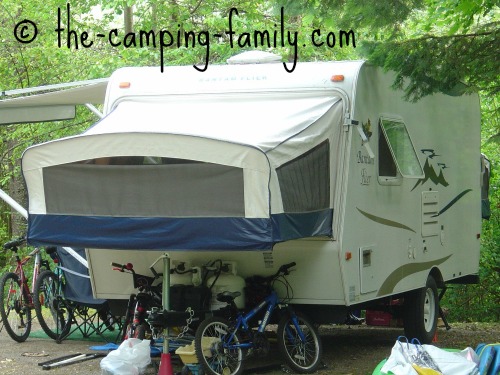Heat Stroke First Aid
I hope that you will never need to know about heat stroke first aid! Heat stroke is a very dangerous, potentially life-threatening situation.
Fortunately, you can prevent heat stroke by following some basic common sense rules.

Portable Shower for Camping
This portable rechargeable camping shower set means you can shower anywhere!
Read more at Amazon here and find the best price!!
Heat Stroke First Aid
Our bodies are designed to stay at about 98.6 degrees Fahrenheit. (That's 37 degrees Celsius.)
We have all sorts of built-in mechanisms to keep us at or near this temperature:
- We perspire. The evaporation of the sweat from our skin lowers our body temperature.
- We transfer heat from the blood to the skin.
- The blood vessels in the skin dilate, allowing heat to easily leave the body.
- We exhale, transferring hot air out of our body.
But sometimes we overwhelm those systems. We heat up faster than our body can cool down.
If this situation is left untreated, we experience symptoms of heat exhaustion, like headache, chills, and dizziness. Click here for detailed information about heat exhaustion symptoms and treatment.
Ideally, we pay attention to those symptoms and take immediate action to fix things. We get out of the sun, have a drink of water, and rest.
What if we don't? Heat exhaustion can turn into heat stroke, a very dangerous and potentially fatal condition. Heat stroke is a medical emergency! Heat stroke first aid must be started as soon as heat stroke symptoms appear.
Symptoms of heat stroke
It's important to note that not all of these heat stroke symptoms will necessarily be present.
High body temperature
A temperature of 106 F (41 C) is dangerously high.
Red skin
The skin may be hot and dry as well as red.
Mental confusion
The patient may suddenly become drowsy or irritable. This can rapidly progress to a state of confusion and agitation - and then to hallucinations.
If left untreated, a heat stroke victim may fall into a coma.
Heat Stroke First Aid
You must bring down the patient's temperature rapidly - but without causing damage.
Here's what to do:
Summon emergency help
Dial 911, or send someone to summon medical aid.
Don't wait until help arrives. Every moment counts! You must take action yourself
Get the victim into the shade
If you have a hammock - and can quickly get the person into it - do so. This allows heat to escape from all directions.
If there is no hammock, lay the person on the ground.
Remove the victim's clothing
Strip off his or her clothes quickly.
Cool the body
- If you have a mist bottle or hose, spray the body with cool water.
- If you don't, pour water over the body.
- Fan the person rapidly to speed up the evaporation of the water.
- Rub ice vigorously on the neck, abdomen, groin and armpits.
Transport to hospital
Continue these measures until the patient improves mentally - or until the body temperature drops to 102 F/39C.
Then, get the patient to an emergency room.
What not to do for heat stroke
Don't shock the body with sudden extreme temperature changes that could cause a heart attack. Don't immerse the person in a cold stream, for example.
How to Prevent Heat Stroke
Rather than having to give heat stroke first aid, learn how to prevent heat stroke in the first place!
Heat stroke occurs when your body heats up faster than your natural cooling mechanisms can cool you down.
Help your body out and let it do what it is designed to do!
- Drink lots of water.
- Avoid overexertion on a hot day.
- Seek out shade.
- Dress in light colors and cool fabrics.
For more tips, read all about heat exhaustion symptoms and prevention here.
Heat Stroke in Dogs
Dogs are more prone to heat stroke than we are.

That's not surprising!
- They are covered in hair.
- They don't have sweat glands all over their body like we do. Theirs are just on their feet.
- Their main method of lowering body temperature is panting, which is not as effective as sweating.
Avoiding Heat Stroke in Dogs
This may sound obvious, but too many dogs get heat stroke every year because their owners ignore this common sense rule:
Never Leave A Dog In A Parked Car On A Warm Day
Even with the windows partly open, a car can heat up to a dangerous temperature very quickly.
Also,
- Don't exercise your dogs vigorously on a hot or humid day.
- Provide your dogs with fresh cool drinking water at all times. Change the water when it gets warm.
- Be sure that your dogs have a shady spot where they can hang out.
Heat Stroke Symptoms in Dogs
Dogs might exhibit some of the same signs of heat stroke as humans:
- weakness
- anxiety
- fever
- rapid heartbeat
- diarhhea
- vomiting
- collapse
Watch also for these dog-specific heat stroke symptoms:
- rapid heavy panting
- heavy drooling
- deep red hemorrhages on the gums or the skin
- bright red gums
Heat stroke first aid for dogs is similar to that for humans:
- Get your dog out of the heat.
- Provide a drink of cool water.
- Cool your dog down with cool water.
- Call your vet right away.
Now that you know about heat stroke first aid, read about more basic first aid instructions for camping.
Before you finalize your camping trip plans, be sure to visit the Camping Family home page. You'll find oodles of helpful information!
Most Popular
Product of the Month
Iwatani Camp Stove
The perfect portable cooktop!
CLICK HERE for more information and best price
Recent Articles
-
Lentil Salad Recipe: Easy Camping Recipe For Lentil Salad
Apr 21, 25 10:46 AM
This easy lentil salad recipe is perfect for a camping trip. You do all the prep work at home, so at camp there is nothing to do but enjoy! -
Hybrid Travel Trailers: Lightweight Expandable RVs
Apr 21, 25 10:38 AM
Hybrid travel trailers combine the convenience of regular travel trailers with the gas economy of pop up tent trailers. Here's how to decide if these expandable trailers are right for you. -
How to Treat A Sunburn: Relieve Itching, Pain, Blisters
Apr 21, 25 10:34 AM
Knowing how to treat a sunburn is the second most important piece of knowledge you should have in the summer.




